|
Targa Florio
|
1906 - 1977 |
Country: |
 |
|
Vincenzo Florio
The Targa Florio was the world's last classic road race when it was run, ostensibly for the final time, in 1974 after having been held 54 previous times. Initiated in 1906, the year after the first RAC Tourist Trophy, it was second only to that race in its great age. In fact, for years devoted followers of the Sicilian event proudly boasted that their race preceded the first Grand Prix - if only by 50 days.
The Targa Florio was the idea of Vincenzo Florio, a member of one of the most wealthy families on the island of Sicily. By the time he was 21 Vincenzo Florio was a widely-travelled and sophisticated young man with experience in many sports, but passionately in love with the motor car. Florio's first car was a De Dion Bouton tricycle, the first form of motorised transport on the island.
The Coppa Florio
As cars from Europe's leading manufacturers were purchased to form a large stable of machinery, Florio decided to organise competitions, such as a speed test featuring his De Dion, a horse rider and a cyclist. He then began to take part in races in Europe. In 1900 he inaugurated the Coppa Florio race run on the mainland of Italy. When Vincenzo Florio's enthusiasm spurred him to inaugurate a motor race around his beloved Sicily, people thought him mad... probably because Sicily had no proper roads.
Eventually a 92-48-mile circuit was worked out. The course began at the sea front near Cerda railway station then climbed into the mountains using tracks more suited to goats than cars, reaching a height of 3670 feet above sea level before beginning plunging down again. Another feature was a three-mile straight along the sea-front after Campofelice. The race was to be known as the Targa Florio (the Florio plate, or shield) and the circuit, embracing 2200 corners, was known as the Grande Circuito delle Madonie after the range of mountains it traversed.
The Grande Circuito delle Madonie
The first race was un on 6 May, 1906, although only 10 of the 22 entries made the start. A French shipping strike held up the Darracq and Mors teams. Winner was Alexandre Cagno at the wheel of an
Itala; he took 9 hours 32 minutes 22 seconds to cover three laps of the tortuous circuit, an average speed of 29.07 mph. There were six finishers, among them three other Italas in second, fourth and fifth positions. Cagno, from Turin, won a solid gold plate for his efforts.
The Messina Earthquake
No fewer than 47 started the second Targa Florio in 1907 when Florio's great friend and former chauffeur Felice Nazzaro won in a FIAT at an average speed of 33-40 mph. His team-mate Vinenzo Lancia was second 12 minutes behind. Only 13 cars started in 1908, despite the rapidly growing recognition of the race, now reduced to two laps. An
Isotta Fraschini driven by Vincenzo Trucco won. The following year the Messina earthquake disrupted the race but Florio reduced the length of the race further to one lap and entered himself in a FIAT and several friends in
De Dion Boutons, machines never intended for racing. Baron Francesco Ciuppa in a SPA beat Florio by a minute.
The Giro di Sicilia
The entries were poor once more in 1910 - when F. Cariolato's Franco won the two-lap race at 29.10 mph but took an hour longer to complete the course that the winner of the combined voiturette event - and in 1911 Ernesto Ceirano's SCAT also averaged 29.10 mph, but over three laps. The format was changed for 1912. Avoiding the mountains altogether, the race was incorporated with the Giro di Sicilia, a single lap of 652 miles to and from Palermo. Florio drove a Mercedes in the 1912 event but became so tired that he drove himself up onto raised tram lines - and out of the race.
Cyril Snipe
A Florio car was also in the running, Vincenzo Florio having financed the short-lived project of an ambitious engineer from Turin. British driver Cyril Snipe, who worked in Turin, had over two hours' advantage at the wheel of his SCAT when he was overcome with exhaustion. He stopped his car, got out, laid down and fell asleep. His co-driver Pardini failed to arouse him for two hours. A bucket of water tossed over the slumbering Snipe had the desired effect as Snipe restarted and won by half an hour at an average speed of 24.30 mph.
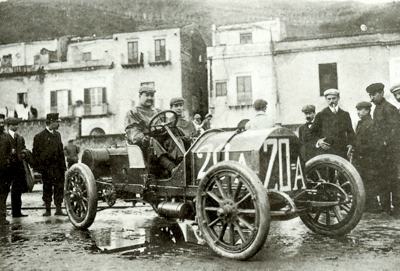 Vincenzo Lancia poses in his Fiat prior to the 1907 Targa Florio.
Vincenzo Lancia poses in his Fiat prior to the 1907 Targa Florio.
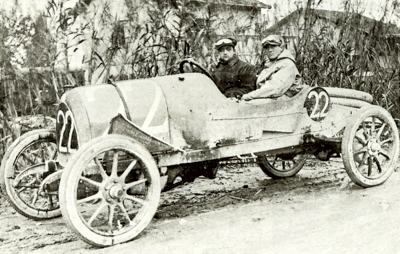 A 1919 CMN waiting for the start of the Targa Florio. The driver is Enzo Ferrari.
A 1919 CMN waiting for the start of the Targa Florio. The driver is Enzo Ferrari.
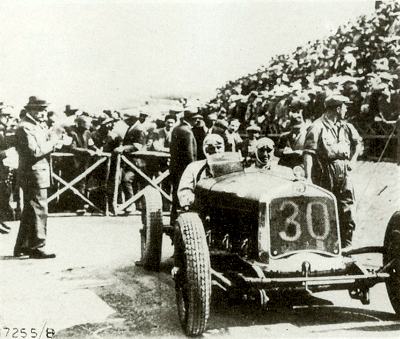 Achille Varzi and the PS Alfa Romeo at the 1930 Targa Florio.
Achille Varzi and the PS Alfa Romeo at the 1930 Targa Florio.
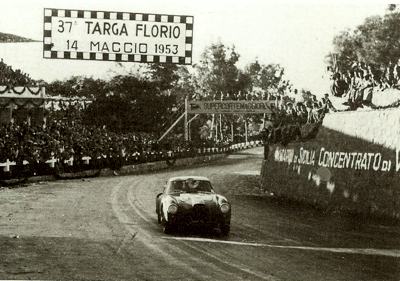 Umberto Maglioli's 3 liter D23 Lancia seen during the 37th Targa Florio in 1953. Maglioli would win the event at an average speed of 51.10 miles per hour.
Umberto Maglioli's 3 liter D23 Lancia seen during the 37th Targa Florio in 1953. Maglioli would win the event at an average speed of 51.10 miles per hour.
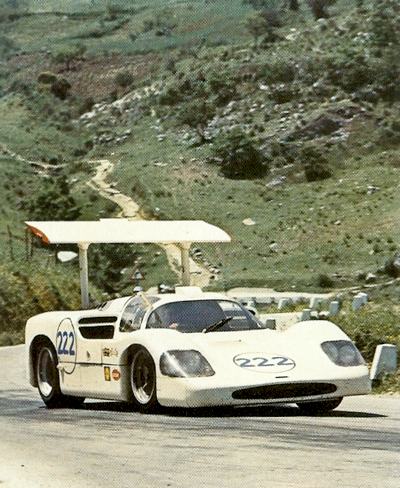 Phil Hill / Hap Sharp Chaparral 2F Coupe during the 1967 Targa Florio.
Phil Hill / Hap Sharp Chaparral 2F Coupe during the 1967 Targa Florio.
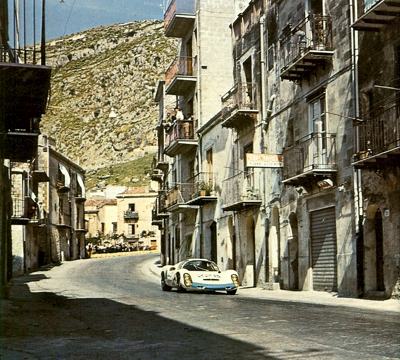 Winner of the 1967 Targa Florio, the Porsche 910/8 of Paul Hawkins and Rolf Stommelen blasts through Collesano on its way to victory.
Winner of the 1967 Targa Florio, the Porsche 910/8 of Paul Hawkins and Rolf Stommelen blasts through Collesano on its way to victory.
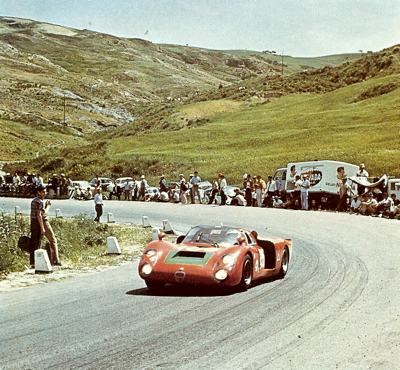 1968 Targa Florio, with an Alfa rounding a corner.
1968 Targa Florio, with an Alfa rounding a corner.
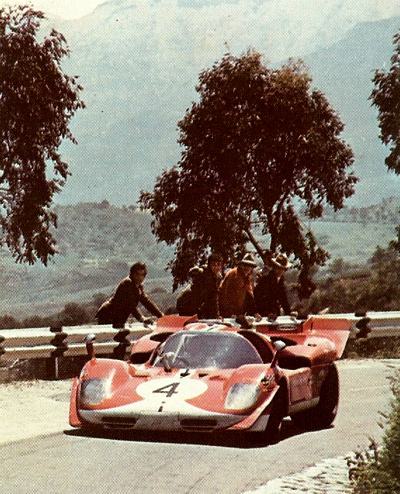 Parkes / Muller Ferrari near Campofelice in 1970.
Parkes / Muller Ferrari near Campofelice in 1970.
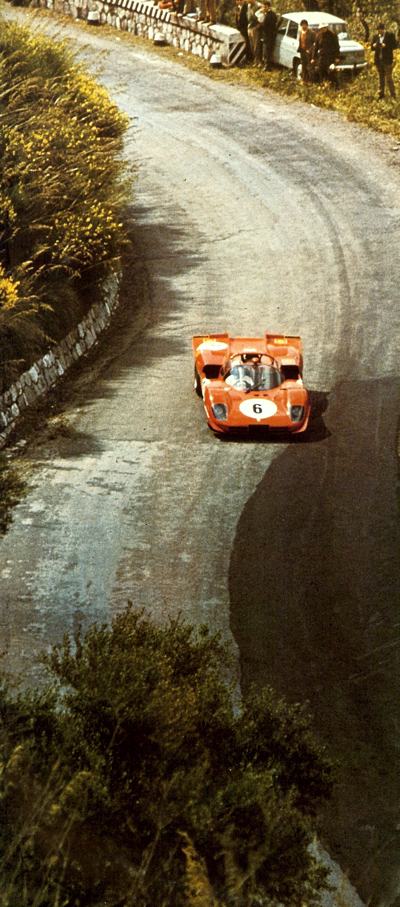 Ferrari 512 at the 1970 Targa Florio.
Ferrari 512 at the 1970 Targa Florio.
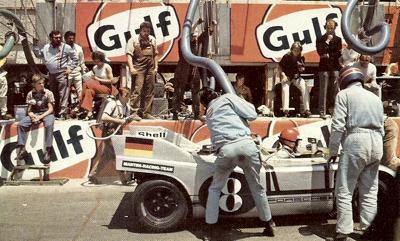 1970 Targa Florio pit stop.
1970 Targa Florio pit stop.
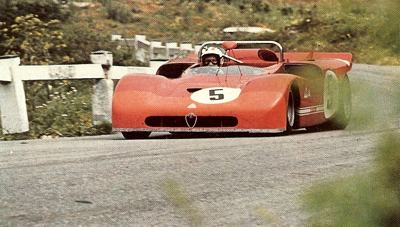 Nino Vaccarella in his Alfa 33 during the 1971 Targa Florio. Vaccarella was a Sicilian, and was therefore always a favorite with the crowds.
Nino Vaccarella in his Alfa 33 during the 1971 Targa Florio. Vaccarella was a Sicilian, and was therefore always a favorite with the crowds.
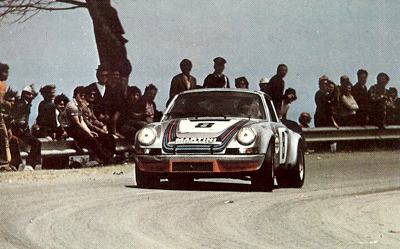 1973 Targa Florio winner was the Van Lennep / Muller Porsche.
1973 Targa Florio winner was the Van Lennep / Muller Porsche.
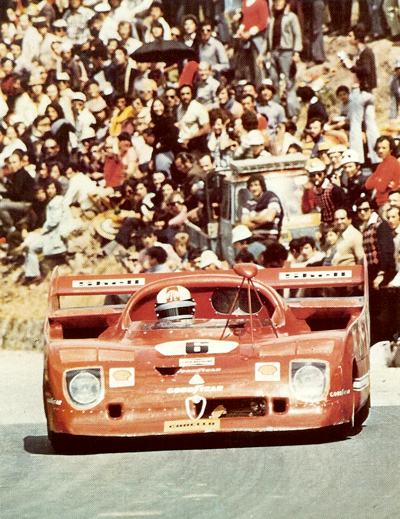
Rolf Stommelen and the works Alfa Romeo in the 1973 Targa Florio. |
Felice Nazzaro
The Giro di Sicilia format was retained until 1914, except that there was a half-way halt at Agrigenta. In 1913 Felice Nazzaro, formerly a driver for FIAT, appeared with a car of his own construction and won at 31.04 mph, while the following year Ernesto Ceirano's SCAT upped this to 38.94 mph. Following World War 1 the race was revived at the end of November 1919. A decision was made to return to the mountains over a shorter course, the Medium Madonie which became known as the Polizzi circuit. Of 67.11 miles in length, it was a daunting prospect. The weather was fine at the startline, but 3000 ft up in the mountains there was snow, slush, mud and low clouds.
The Polizzi Circuit
The first to set off in the traditional staggered-start pattern, was Enzo Ferrari, driving a CMN, but he was not to feature. The battle was between two Frenchmen, veteran Rene Thomas (Ballot) and the young, reckless Andre Boillot (Peugeot). Thomas crashed on one of the 1500 corners of the new Polizzi circuit, leaving Boillot the winner. But only just..., as Boillot, near the end of the race was exhausted, and skidded on the greasy track only a few yards from the finish line. The Peugeot charged a wooden grandstand, but willing helpers put Boillot and his riding mechanic back in their seats and they engaged reverse gear to cross the line backwards.
C'est pour la France
Ernest Ballot (the constructor of their crashed rivals car) feared disqualification for such a manoeuvre, and persuaded the tired crew to drive away, turn around and cross the line again front first! They did, Boillot collapsing immediately afterwards murmuring, 'C'est pour la France'. The 1920 race-won by Guido Meregalli in a Nazzaro, a car built by the 1907 winner - was dull and held in terrible weather. From 1921 until the mid-1930s the Targa Florio garnered increasing prestige. Works teams from all over Europe were attracted:
Alfa Romeo,
Fiat,
Mercedes,
Itala,
Delage,
Peugeot,
Bugatti,
Sunbeam and Ballot. Ranged against the cream of the professional factory drivers were top amateurs.
Count Giulio Masetti
In 1921 Italian Count Giulio Masetti, driving a 4.4-liter Grand Prix Fiat built in 1914, beat a solitary factory-entered 7.3-liter Mercedes 28/95 driven by Max Sailer. In 1922 Mercedes entered a full works team of six cars, but they were soundly beaten by a privately-entered Mercedes, the 4
½-liter 1914 Grand Prix model of Masetti, who became the first driver to win two successive Targa Florios. Ugo Sivocci and Antonio Ascari registered an Alfa Romeo 1-2 victory in 1923, the first of nine wins for the Milanese marque in a period of 48 years.
Christian Werner
The 15th running of the Targa Florio in 1924 saw it combine with the Coppa Florio. Targa competitors had to run four laps, as usual, then run an extra lap for the Coppa Florio. Following a battle with the Alfa Romeos of Ascari and Masetti, German Christian Werner triumphed in his 2-liter Mercedes, From 1925 until 1929 Bugatti ruled the roost in Sicily. Meo Costantini, a Milanese who worked for Bugatti in Molsheim, conquered the works Peugeots in his 2-liter Bugatti T35. That year the Targa Florio was over five laps and the Coppa Florio over four, the same format being employed in 1926 when Costantini won again, this time with a 2.3-Iitre Bugatti T35T. It was a sad year, previous twice-winner Masetti being killed when his works Delage inexplicably overturned.
Emilio Materassi
Emilio Materassi, a new recruit to the Bugatti team, won in 1927 in a 2-Iitre supercharged T35C, heading Count Conelli's 1
½ liter supercharged T37A model. Elizabeth Junek, from Prague, entered her z.j-liter Bugatti T3SB, but retired early owing to steering problems, after holding fourth place behind three works-entered Bugattis at the end of the opening lap. Before the race Elizabeth and her husband Cenek had spent a month learning the circuit, including a lap on foot at the rate of 12 miles per day.
Elizabeth Junek was the sensation of the following year's race. She fought for the lead with such legendary greats as Albert Divo, the ultimate winner in a Bugatti T35B, Giuseppe Campari and Tazio Nuvolari, but a water leak caused the engine to overheat on the fifth and last lap and she dropped to fifth. (Sadly her husband was killed two months later and she retired from racing.) Fourth man Louis Chiron (Bugatti T35B) actually completed a sixth lap, claiming not to have realised the race was over!
It was Divo once more in 1929 when only six of the nineteen starters were able to survive the record-breaking pace to the finish. The 1930 race was an epic struggle between Alfa Romeo and Bugatti. At the end there were two men straining every muscle, every nerve to seek the utmost from their over-worked machines: Achille Varzi and Louis Chiron. Varzi pinned his faith on a Grand Prix type 2-liter Alfa Romeo P2, a very difficult car to handle on the circuit, while Chiron hoped to score Bugatti's sixth win in his 2.3-liter Bugatti T35B. Both had problems. Chiron crashed into a wall and had to change two wheels, while Varzi in trying to save time by refuelling from a can while still racing, set the rear of the car aflame. The verdict went to Varzi by a mere 1 minute 48.4 seconds after almost seven hours of racing.
Alfa Romeo won the next five races as well, thereby avenging Bugatti's glory. Instead of an inter-marque battle the Targa Florio now became the personal feuding ground of arch-rivals and ex-Alfa Romeo team-mates, Achille Varzi and Tazio Nuvolari. Varzi borrowed a Bugatti T51 for the 22nd running of the race, which had to revert to the old Grand Madonie circuit (for four laps) after a cyclone destroyed roads and bridges on the Polizzi circuit. For three laps Varzi's red-painted Bugatti remained ahead, but then it rained and the Alfa Rorneos, which were fitted with right-hand wings to protect their drivers from spray, had the advantage. Varzi, exhausted, finished first on the road but the Alfas had more than made up their difference of starting time and a jubilant Nuvolari was acclaimed the winner.
Mussolini's Piccolo Circuito delle Madonie
Vincenzo Florio successfully talked Mussolini into financing a loop road to avoid sections of the Polizzi circuit prone to bad weather conditions creating the Piccolo Circuito delle Madonie, at 44.74 miles, in I932. It had to be covered eight times. Nuvolari triumphed once more in a 2.3-Iitre Alfa Romeo Monza from team-mate Baconin Borzacchini. Marquis Antonio Brivio won the 1933 Targa Florio in a year in which Alfa Romeo seemed virtually unopposed, while in 1934 Varzi won in an Alfa Romeo when Nuvolari was absent. Brivio won again in 1935, leading seven Alfa Romeos in the first eight positions.
Only two laps of the Piccolo Madonie circuit for 1 liter sports cars comprised the December 1936 Targa Florio. Lancia took the first four places, headed by Magistri's 1.2-liter Augusta. In 1937 Vincenzo Florio no longer held an official position in the Sicilian Automobile Club, which instituted completely different events: 1
½ -iitre voiturette races at the Parco della Favorita on the outskirts of Palermo where a short and fast circuit was laid out. The race was run to this emaciated format for four years. Maseratis took the first three places each time. Francesco Severi's 6CM model triumphed in 1937, G. Rocco's similar model in 1938 and Luigi Villoresi won comfortably in both 1939 and 1940 with the new Maserati 4CL.
The Giro di Sicilia Series
The Second World War left its mark on Sicily. The buildings along the sea-front at Palermo had been bombed into ruins, the grandstand at Cerda had been blown-up and the race control tower disassembled. The roads themselves were in an extremely poor state and when the Targa Florio returned to the motor racing calendar in 1948 - with Vincenzo Florio also back in action - it was incorporated in the Giro di Sicilia series. Driving a 2-Iitre Ferrari 166
Mille Miglia, veteran Clemente Biondetti and his co-driver Count Igor Troubetskoy easily won the race with the 1100cc Fiat-engined works
Cisitalias of Taruffi / Rabbia and Machieraldo / Savio an encouraging second and third.
Rain, thunderstorms and fog marred the running of the 1949 race when a British car led until shortly after distance. This was the Bristol-engined
Frazer-Nash High Speed model shared by Dorino Serafini / Rudi Hailer, but it was to skid in the treacherous conditions and bend a steering arm. The race was now contested between last year's winner Biondetti in the Ferrari and Franco Rol in a 2
½-liter Alfa Romeo. With Rol delayed over five minutes at a level crossing, Biondetti won by 2 minutes 51 seconds in a race lasting 13 hours 15 minutes 9 seconds.
The Ferrari 340 America
The last Targa Florio of the Giro di Sicilia format was in 1950, proving a real race of attrition with 79 finishers from 186 starters. One leader after another succumbed to mechanical failure, leaving Mario and Franco Bornigia to win in a 2
½-liter Alfa Romeo. In 1951 it was back to the Piccolo Madonie circuit. From 25 starters there were only eight finishers. Giovanni Bracco's 4.1-liter Ferrari 340 America set a sizzling pace, but its suspension wilted under the strain and Franco Cortese came through to win after a cool, calculated drive in a 2-liter Frazer-Nash Le Mans Replica. It was the first - and only - victory by a British car. Bracco, taking over a 2.5-Iitre Ferrari 212 Sport, salvaged second place and also broke the lap record, recording 52 minutes 24.8 seconds on his sixth lap.
Lancias 1-2-3 Victory
Lancias swept the board with a 1-2-3 victory in 1952, but only after Bracco's big Ferrari had retired early, Giulio Cabianca's tiny 1350cc OSCA had broken its back axle on the seventh of the eight laps and Cartese's well-known Nash had fallen into a ditch on the very last lap. Winner Felice Bonetto almost did not make it. His 2-liter Lancia Aurelia GT ran out of petrol on the long Buonfornello straight leading to the start/finish area. He borrowed a liter of fuel but this, too, was consumed mere yards from the line. Bonetto pushed his car uphill and, on the point of collapse, climbed aboard to cross the line on the starter motor. Bonetto still set a new winning average of 49.73 mph while Cabianca's little OSCA had lowered the circuit record to 51minutes 17.4 seconds, at 52·34mph.
Lancia returned in 1953 with a team of 3-liter sports-racing models, the D23s. Umberto Maglioli won at 51.10 mph and team-mate Piero Taruffi became the first lap record holder at under 50 minutes, recording 49 m 37.0 s, 54.10 mph. In 1954 Lancia won again, Taruffi in a 3.3-liter D24 averaging a record 55.88 mph to beat Luigi Musso's 2-liter Maserati A6GCS by over 7
½ minutes. Musso, the initial leader, had lost several minutes owing to sickness, having eaten unwisely the night before. Taruffi's team-mate Eugenio Castellotti crashed his Lancia D24 not before he also smashed the lap record with 57.86 mph.
The World Sports Car Championship
The Targa Florio received a great accolade in 1955 when it became a qualifying round of the World Sports Car Championship. The race distance was lengthened to 13 laps and, with an October date, it became the final and deciding round of the series. Prior to the race Ferrari led with nineteen points, three more than either Mercedes-Benz and Jaguar. When Jaguar decided not to enter, it became a two-way battle.
Stirling Moss's 3-liter Mercedes-Benz 300SLR set the early pace, but on lap 4 the Englishman overshot a bend and landed six foot down in a field. The car was slightly damaged and with the aid of a large band of peasants it was manhandled back on to the track.
Repaired as best as possible in the pits, the Mercedes was taken over by Peter Collins who proved as fast as his partner and the pair moved into the lead again. Team-mates
Juan Manuel Fangio / Karl Kling were second, to ensure Mercedes won the championship, with the best Ferrari placing third. This was the 3.4-liter 860 Monza model crewed by Eugenio Castellotti / Robert Manzon. Moss lowered the lap record to 43 minutes 7.4 seconds, 62.22 mph.
Umberto Maglioli's Porsche RS
The race was not in the 1956 World Sports Car Championship series, providing a surprise win for Porsche. The tiny, 1500cc Porsche RS was driven by Umberto Maglioli, an experienced driver thoroughly at home in the Sicilian mountains, and German Huschke von Hanstein. Giulio Cabianca (1.5-Iitre OSCA) was initially awarded second place, but as his co-driver Luigi Villoresi had already driven another entry he was disqualified and the place given to Piero Taruffi (3-Iitre Maserati 300S).
1957 was the year of the
Mille Miglia disaster in which two drivers and eleven spectators were killed, the Targa Florio was run as a regularity trial. The race was back with a vengeance in 1958, over fourteen laps and back in the championship calendar. Stirling Moss set the pace in his works Aston Martin DBR 1/300, breaking the lap record with 42 minutes 17.5 seconds, at 63.47 mph, but its gearbox broke, leaving Luigi Musso / Olivier Gendebien to win in a Ferrari 250 Testa Rossa. Ferrari's attack in the 1959 event failed, leaving the race a Porsche procession. Germans Edgar Barth / Wolfgang Seidel won in a 1
½-liter works-entered Porsche RSK, finishing 20 minutes in front of the privately-entered Porsche RS of Eberhard Mahle / Paul Strahle / Herbert Linge.
Lucia and Paladino Florio
After Vincenzo Florio died at 76, there might not have been a Targa Florio in 1959, or any subsequent year. Fortunately his widow Lucia Florio, aided by her grandson Paladino and other Sicilians, ensured the race would carry on. In the 1960s the Targa Florio became unique as a road race, When great strides were made in motor racing safety, few people thought it could survive into the 1970s. Although it remained part of the sports car championship scene; it did not always attract full factory participation. However, it continued to be supported by a host of amateur drivers in varying types of machinery, people who loved the relic of the past.
Umberto Maglioli put up a brave show with a 2.9-liter Maserati T61, but a ruptured fuel tank caused its retirement and the 10-lap 1960 Targa Florio belonged to
Joakim Bonnier / Hans Herrmann in a 1.7-liter Porsche RS60. Six minutes behind followed the 2.4-Iitre Ferrari Dino 246s of
Phil Hill /
Wolfgang von Trips. In 1961
Stirling Moss / Graham Hill appeared all set for victory in a 2-Iitre Porsche RS61, but six miles from the finish, when holding a comfortable lead, Moss had the transmission seize owing to lack of oil. This gave victory to the works Ferrari Dino 246s of Wolfgang von Trips / Olivier Gendebien; on his last lap von Trips cracked the lap record with 40 minutes 3.4 seconds, 67.01 mph.
Ferrari vs. Porsche
It was Ferrari v Porsche once more in 1962 when the Italian team won again. A 2.4-liter Dino 246SP driven by the trio Ricardo Rodriguez / Willy Mairesse / Olivier Gendebien led home their team-mates Giancarlo Baghetti / Lorenzo Bandini (2-liter Ferrari Dino 196SP) by 11
½ minutes. Mairesse lowered the record to 40 minutes 0.3 seconds, 67.06 mph. However the 1963 race was a disaster for Ferrari. His own car having broken-down, fiery Belgian Willy Mairesse took over the 2-liter Ferrari Dino 196SP driven by Lorenzo Bandini / Lodovico Scarfiotti and, with victory in sight, he spun on the final lap. Dragging his rear engine cover, the car made it to the finish line 12 seconds behind the eight-cylinder Porsche 718 coupe raced by Jo Bonnier and Carlo Mario Abate.
Ferrari did not enter the 1964 race, while the Porsche prototypes retired, leaving victory to Colin Davis / Antonio Pucci in a GT Porsche 904 GTs. A team of Anglo-American AC Cobras was entered, but although team leader Dan Gurney worked his way up to second place the big 4.7-liter machines were not suited to the rough circuit and fell back with suspension damage. Ferrari returned in 1965 when Sicilian school-teacher Nino Vaccarella set a scorching pace in the 3.3-liter Ferrari 275P2 he shared with Lorenzo Bandini. The pair won by over 4 minutes and Vaccarella set the first sub-40 minute lap record: 39 minutes 21.0 seconds, at 68.21 mph. With the failure of the two other Ferrari prototypes and an open Ford GT 40, works Porsches occupied second, third and fourth positions.
The 7-liter Chev Engined Chaparral 2F
In 1966 the pace was so quick in treacherously wet conditions that the favorites - works-entered Ferraris and Porsches - failed, allowing the Swiss-entered Porsche 906 crewed by Willy Mairesse / Hlerbert Muller to win the 50th Targa Florio very easily. That remarkable machine, the 7-liter Chevrolet-engined Chaparral 2F, ran in the 1967 race. The winged car, crewed by Americans Phil Hill / Hap Sharp, was not suited to the roads but was in fourth place when its transmission failed on lap 9. Ferrari's single entry of a 4-liter 330P4 for Nino Vaccarella / Lodovico Scarfiotti was out on the very first lap when Vaccarella hit a wall, and ultimately the race developed into another Porsche benefit, the German cars taking the first three places led by the 2.2-liter 910/8 of Paul Hawkins / Rolf Stommelen. Swiss Herbert Muller, at the wheel of a 4-liter Ferrari 365P3/4, set best lap of 37 minutes 9.0 seconds, at 72.25 mph.
Alfa Romeo almost took the laurels the following year as the Nanni Galli / Ignazio Giunti 2-Iitre T33 led into the last lap. But
Vic Elford, rally-turned-racing star, was in rare form. His 2.2-Iitre Porsche 907 had lost 17 minutes on the first lap when a wheel came off - twice - and his co-driver, the veteran Umberto Maglioli, was not as fast as before, but by lowering the record to an amazing 36 minutes 2.3 seconds, at 74.49 mph, Elford snatched victory by almost 3 minutes.
In 1969 Elford reduced his record still further to 35 minutes 8.2 s, 76.39 mph, but a broken alternator belt dropped him to second behind the sister works Porsche 908/02 Spyder of Gerhard Mitter/Udo Schutz. Porsche, knowing their 5-liter 917s to be unsuited to the Piccolo Madonie circuit, built new cars especially for the 1970 Targa Florio, the short-wheelbase 908/03 Spyders. They were first, second and fifth (Jo Siffert / Brian Redman, Pedro Rodriguez / Leo Kinnunen, Dickie Attwood / Bjorn Waldegard) in the 11-lap race, and Kinnunen established a resounding lap record of 33 minutes 36.0 seconds, 79.89 mph, a time never to be beaten. Nino Vaccarella / Ignazio Giunti bravely drove a big 5-liter Ferrari 512S and were rewarded with a fine third place.
An End to Porsche's run of Successive Victories
Porsche's run of five successive victories was halted in 1971. With the German cars running into uncharacteristic trouble early in the race, the works Alfa Romeo T33/3s took first and second places. Nino-Vaccarella shared the winning car with Toine Hezemans, while Andrea de Adamich / Gijs van Lennep followed them home 1 minute 11.7 seconds behind. Alfa were favorites once more in 1972 as only a lone works Ferrari 312P crewed by Arturo Merzario / Sandro Munari opposed their four entries. Vic Elford's Alfa Romeo T33TT/3 blew-up on the first lap, then the engine failed on the Nino Vaccarella / Rolf Stommelen car. Later Toine Hezemans, sharing his Alfa with Andrea de Adamich, broke a wheel and lost valuable time, but still the Nanni Galli / Helmut Marko car led the Ferrari. Drama intervened when Galli spun avoiding a backmarker and lost two minutes restarting; although co-driver Marko made up ground quickly, the Ferrari triumphed by 16.9 seconds.
Before the 1973 race the FIA announced that the Targa Florio would lose its championship status the following year. The race was now unsuited to the sports-prototypes of the 1970s, but Alfa Romeo and Ferrari entered two cars each. All four failed, however, leaving victory to a Martini-sponsored works Porsche 911 Carrera RSR crewed by Gijs van Lennep / Herbert Muller and a car equally suited to the tough Sicilian track, Sandro Munari and Jean-Claude Andruet's 2.4-liter
Lancia Stratos.
A non-championship GT Targa Florio, run over seven laps, was held in 1974. It was won by the Lancia Stratos of Gerard Larrousse/ Amilcar Ballestrieri. No race was inscribed on the 1975 international calendar. Sports cars did go to Sicily for a championship race, however, but it was not to the projected 3.75-mile artificial road circuit at Cerda talked about in the past by the Automobile Club di Palermo where they had hoped to run future Targa Florios. They went to Enna, a Sicilian track completely unconnected with the Targa Florio.
Also see:
Mille Miglia |
The History of the Targa Florio (AUS Edition)
